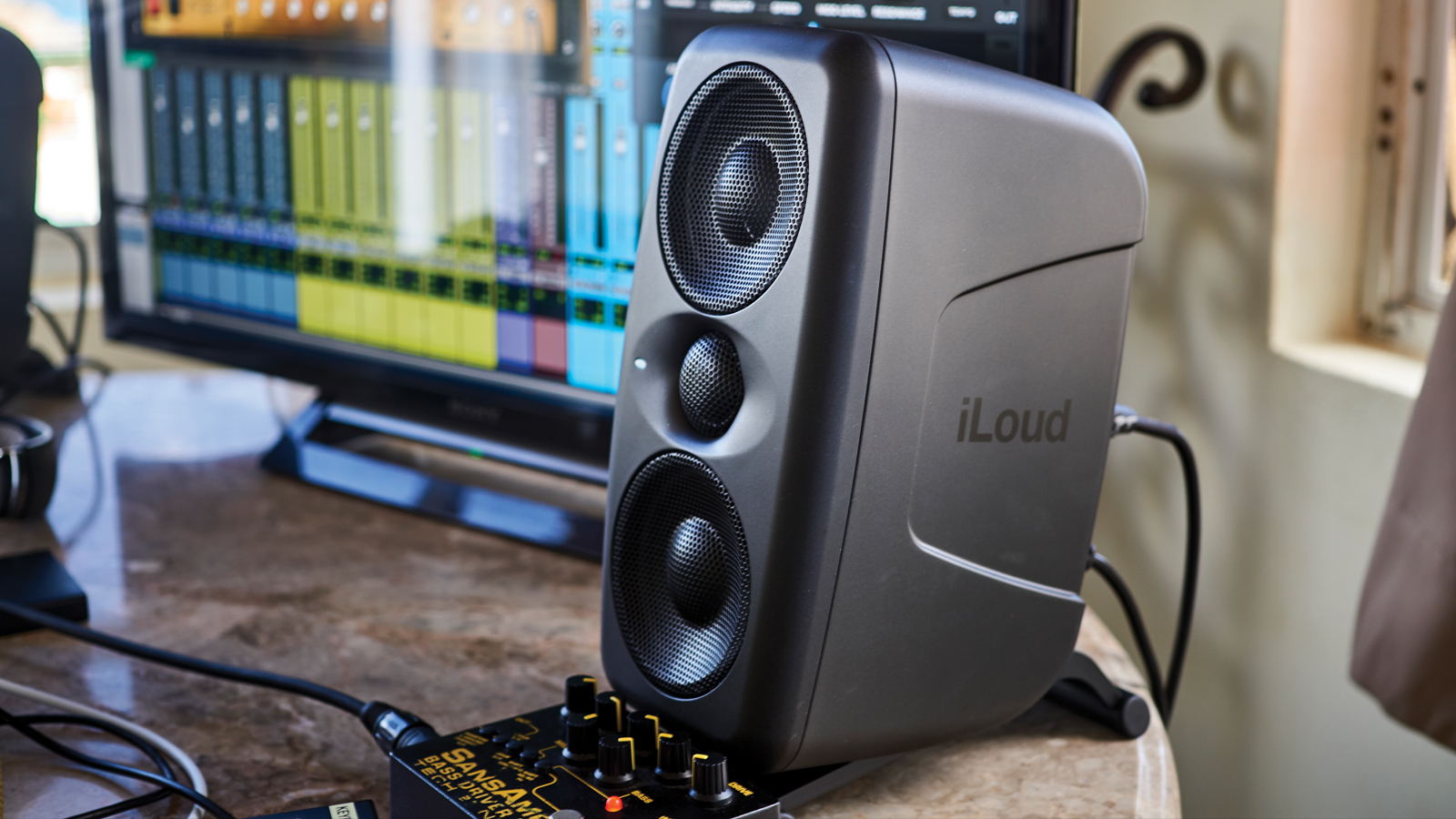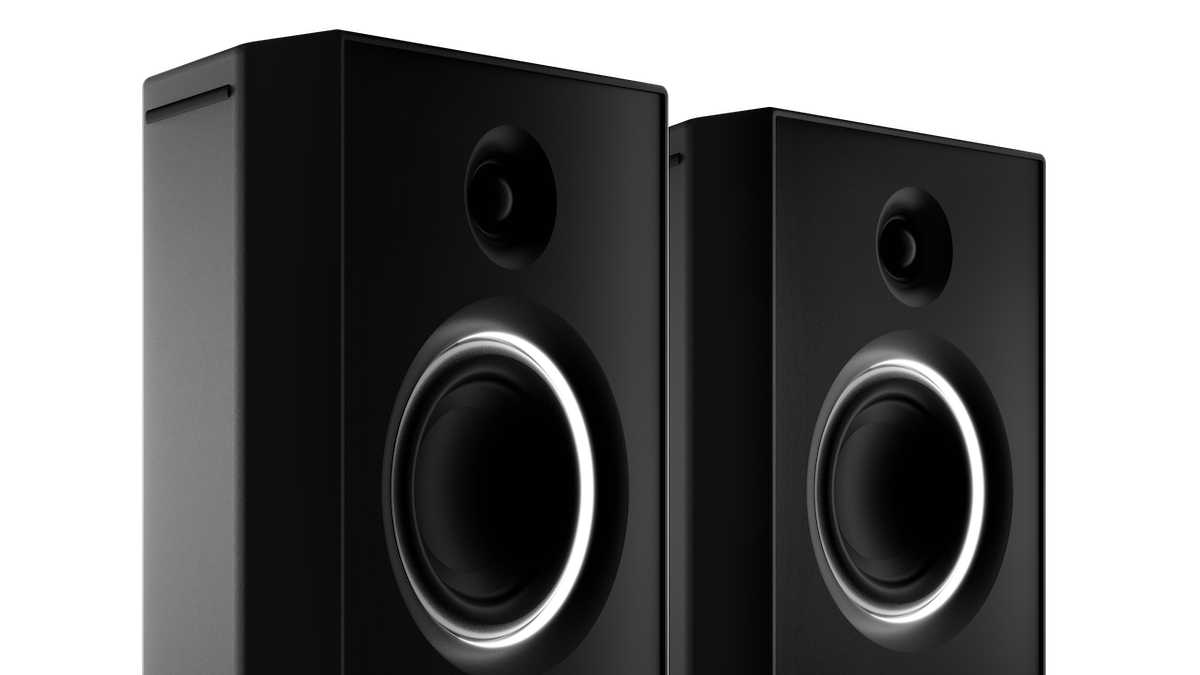MusicRadar Verdict
Great sounding and (almost) latency-free wireless monitoring – we never thought we'd see the day. While you might not absolutely need Unit-4, this is undoubtedly a very desirable monitoring setup.
Pros
- +
Fantastic sound.
- +
Pretty much latency-free.
- +
Such an easy setup.
- +
The white LEDs look very cool!
Cons
- -
Do you really need wireless studio monitors? (Be honest)
MusicRadar's got your back
AIAIAI Unit-4 Wireless+: What is it?
AIAIAI’s £700/$800 Unit-4 Wireless + speakers are billed as the first proper wireless studio monitors. That's because they use Wireless+ technology, which is said to blow Bluetooth (which the speakers can also use) out of the water both in terms of sound quality and latency.
Latency has always been one of the more annoying side effects of Bluetooth audio. it means that trying to record something like a keyboard solo using wireless speakers or headphones is nigh-on impossible thanks to the delay between you playing a note and hearing it. Bluetooth is ok for listening to music, but not producing it.
AIAIAI has form in this area already, having released the TMA2 Wireless+ headphones a couple of years ago. Now it's come with what it hopes is a Bluetooth-bettering set of speakers.

AIAIAI Unit-4 Wireless+: Specs and setup
If you're unfamiliar with AIAIAI products, we can tell you that they are usually very cool, very sleek, black and well designed. These Unit-4 speakers are no different: as soon as you open the box and enjoy the Apple unboxing-style experience, you know that there’s been some thought put into these monitors.
The speakers themselves are well built, compact, made from 100% recycled plastic, and not too heavy at 2.5kg. They are portable, then, but you wouldn't want to carry them around in the odd cotton drawstring pouches that they come in. Fortunately, there is an optional case available for £60/$70 that looks like it would do a good job.
They do ship with magnetic protective grills, though, and there's a full optional surround protector also available for £25/$30 per speaker.
Each speaker has 3.5-mm mini-jack and 6.3mm TRS balanced inputs, 1-inch silk dome tweeters and 4-inch 'high excursion' paper cone woofers. The Unit-4 boasts a pretty flat (+/-2dB) frequency response between 50Hz and 20kHz.
Want all the hottest music and gear news, reviews, deals, features and more, direct to your inbox? Sign up here.
There's also a power socket on each speaker so you can hook up to the mains when you need/want to.

The fact that we got up and running with the Unit-4 system within minutes says more about how much effort AIAIAI has put into the sleek setup workflow of the speakers than it does about our skills at going wireless.
The procedure is basically this: plug the X02 Wireless+ transmitter into the USB-C port of your audio device (there's also an aux in on the transmitter if you need it), switch the speakers on and make sure they are each set as left and right and connected to W+ rather than the Bluetooth option. And that's it, because the W+ USB connector picks up the speakers automatically, doing the hard work for you.
We tested the Unit-4s with Ableton Live and Logic Pro, both of which picked them up as standard outputs, and then poured our music into the speakers, as if by magic.

There's the inevitable Unit-4 app, too, which connects to the speakers via Bluetooth. This enables you to adjust the frequency curve depending on their location, and also dim the front white circular LED rings that are on the front of each speaker, should you wish.
Talking of which, while these flashed annoyingly as we set the speakers up – leading us to think that it could be one innovation too far – they settle on just being a white ring on the speakers which looks particularly cool, especially you you, erm, mix in the dark. Not only that, but the rings also serve other purposes like telling you how much charge you have left when you hit the power button twice, a full white ring equating to a full charge.

AIAIAI Unit-4 Wireless+: Performance and verdict
Once we'd set the system up, we have to say we were quickly impressed. The most important aspect for the recording musician is that there is no delay; well, OK, a pretty imperceptible 16ms. Play a note on your connected MIDI keyboard or computer keyboard, and it feels like zero time between you hitting the key and it playing.
The inherent problem with Bluetooth connectivity has always been this latency and the audio compression of the music. The W+ Link certainly does do away with the former, then. And just to prove this to ourselves, and that there is no other black magic at work, we set the speakers up in Bluetooth Mode and, lo and behold, that Bluetooth delay did appear as expected as we struck our keyboard keys.
As to the W+ sound versus the Bluetooth sound, we have to report that's very similar. So we wouldn't say that W+ sounds massively better than the Bluetooth standard, but that says more about how good Bluetooth audio sounds these days rather than any failing in the W+.

• IK Multimedia iLoud MTM
There's little out there to directly compete with Unit-4 but these iLouds are a good mobile speaker option.
• KRK GoAux 3 or 4
Again, not directly comparable, but another great mobile set of speakers with fantastic sound quality.
The fact is that these speakers do sound pretty exceptional given their size, and we'd say that the flat frequency response we discussed earlier is certainly noticeable. There’s a true but rich and clear feel overall; the bass response is surprisingly detailed and the top and mids shimmer gloriously.
We love the imaging, too, something you can play with too as you move the speakers around without any cables getting in the way.
If we had to sum up how we feel about the overall sound, we’d say it's balanced, not coloured and impressively big, all of which are fantastic attributes for any studio monitor.
Verdict
We have to say that we were pretty skeptical before testing these Unit-4s. We’d not exactly been moaning about having wired speakers - once our studio monitors are plumbed in, they stay where they are, so why fret over power cables and audio connections?
However, having worked with the speakers for a while now, we’re certainly warming to the wireless concept. Not only do Unit-4s work seamlessly and sound great, they actually [whisper it, because we’re supposed to be all about audio quality] look great on the shelf. There are less sockets being used (for their 20 hours of charge, anyway) and no wires to get entwined with other audio wires, which ours always seem to.

Any negatives, then? Well, yes, but probably not any deal breakers. The instructions, such as they are, are almost too cool for school, not that you really need them beyond setup. There was also the odd interference crackle - very slight and very quiet. So slight, in fact, that on occasion that we were questioning ourselves whether it actually happened. It's certainly not enough to overtly annoy.
As to whether you absolutely need these speakers, well that is something only you can answer. Is your current wired system truly annoying you with its wires? Do you require speakers that are that much more portable? And do you have £700/$800 to burn for something that just looks much better in your studio.
We can't say that the Unit-4 speakers are an essential purchase – we can put up with wired studio speakers if we really have to - but we can't help wanting them. They are the perfect match for a laptop, and that truly wireless pro-sounding recording setup is finally here. For 20 hours at a time, anyway.
MusicRadar verdict: Great sounding and (almost) latency-free wireless monitoring – we never thought we'd see the day. While you might not absolutely need Unit-4, this is undoubtedly a very desirable monitoring setup.
AIAIAI Unit-4 Wireless+: The web says
"The Unit-4 is a seriously capable studio monitor when used in regular wired mode and a fun party speaker over Bluetooth. But the premium you’re paying is for that third element – the uncompressed wireless mode that lets you monitor, mix or master without a separate interface to connect the speakers."
Musictech.com
AIAIAI Unit-4 Wireless+: Hands-on demos
AIAIAI
In The Mix
AIAIAI Unit-4 Wireless+: Specifications
- Frequency response: 50Hz to 20kHz (±2dB)
- Peak SPL: 105 dBSPL
- Analogue inputs: 3.5mm mini-jack + 6.3mm TRS balanced
- Amplifier power: 2 x 30W continuous, 2 x 80W peak
- Battery playback time: 20 hours
- Battery charge time: 2 hours
- W+ Link latency: 16ms
- Buy at AIAIAI
Andy has been writing about music production and technology for 30 years having started out on Music Technology magazine back in 1992. He has edited the magazines Future Music, Keyboard Review, MusicTech and Computer Music, which he helped launch back in 1998. He owns way too many synthesizers.

